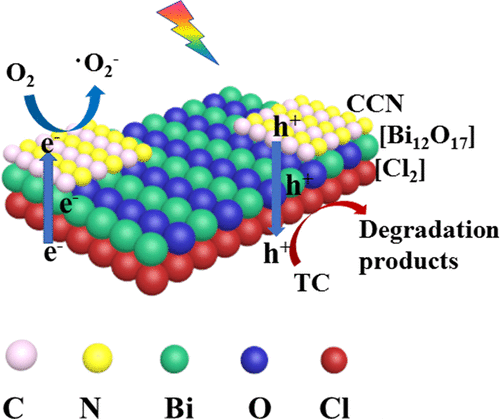当前位置:
X-MOL 学术
›
ACS Sustain. Chem. Eng.
›
论文详情
Our official English website, www.x-mol.net, welcomes your
feedback! (Note: you will need to create a separate account there.)
Rational Design of Carbon-Doped Carbon Nitride/Bi12O17Cl2 Composites: A Promising Candidate Photocatalyst for Boosting Visible-Light-Driven Photocatalytic Degradation of Tetracycline
ACS Sustainable Chemistry & Engineering ( IF 7.1 ) Pub Date : 2018-04-09 00:00:00 , DOI: 10.1021/acssuschemeng.8b00782 Chengyun Zhou 1 , Cui Lai 1 , Piao Xu 1 , Guangming Zeng 1 , Danlian Huang 1 , Zhihao Li 1 , Chen Zhang 1 , Min Cheng 1 , Liang Hu 1 , Jia Wan 1 , Fei Chen 1 , Weiping Xiong 1 , Rui Deng 1
ACS Sustainable Chemistry & Engineering ( IF 7.1 ) Pub Date : 2018-04-09 00:00:00 , DOI: 10.1021/acssuschemeng.8b00782 Chengyun Zhou 1 , Cui Lai 1 , Piao Xu 1 , Guangming Zeng 1 , Danlian Huang 1 , Zhihao Li 1 , Chen Zhang 1 , Min Cheng 1 , Liang Hu 1 , Jia Wan 1 , Fei Chen 1 , Weiping Xiong 1 , Rui Deng 1
Affiliation

|
Many recent advances based on 2D materials have opened new possibilities in photocatalysis. In this paper, a new 2D semiconductor composite consisting of carbon-doped carbon nitride (denoted as CCN) layers and Bi12O17Cl2 layers was designed via an in situ method. A supramolecular chemistry approach was employed to form CCN by using the hydrogen-bonded melamine–cyanuric acid and barbituric acid, and Bi12O17Cl2 layers were obtained by using a moderate solvothermal method. CCN/Bi12O17Cl2 composite had superior photocatalytic performance for degrading antibiotic tetracycline (TC) under visible-light irradiation. The degradation rate constant of 20%CCN/Bi12O17Cl2 is 0.0409 min–1, which is approximately 2.9-, 1.5-, and 32.1-fold those of pristine Bi12O17Cl2, CCN, and BiOCl, respectively. Electrochemical measurements showed that CCN/Bi12O17Cl2 composite has high photogenerated charge carrier separation efficiency. According to the trapping and electron spin resonance results, superoxide radicals and holes were the main active radicals in the degradation of TC. The enhanced photocatalytic activity of CCN/Bi12O17Cl2 can be attributed to enhanced charge separation. It is expected that the CCN/Bi12O17Cl2 composite could be utilized as visible-light photocatalyst for other environmental applications.
中文翻译:

碳掺杂氮化碳/ Bi 12 O 17 Cl 2复合材料的合理设计:一种有前途的候选光催化剂,可促进可见光驱动的四环素光催化降解。
基于2D材料的许多最新进展为光催化开辟了新的可能性。本文采用原位方法设计了一种新型的二维半导体复合材料,该复合材料由掺碳氮化碳层(表示为CCN)和Bi 12 O 17 Cl 2层组成。采用超分子化学方法,通过氢键结合的三聚氰胺-氰尿酸和巴比妥酸形成CCN,并通过中等溶剂热法获得Bi 12 O 17 Cl 2层。CCN / Bi 12 O 17 Cl 2该复合材料在可见光照射下具有优良的降解抗生素四环素的光催化性能。20%CCN / Bi 12 O 17 Cl 2的降解速率常数为0.0409 min –1,分别约为原始Bi 12 O 17 Cl 2,CCN和BiOCl的2.9倍,1.5倍和32.1倍。电化学测量表明,CCN / Bi 12 O 17 Cl 2复合材料具有较高的光生载流子分离效率。根据俘获和电子自旋共振结果,超氧化物自由基和空穴是TC降解的主要活性自由基。CCN / Bi 12 O 17 Cl 2的增强的光催化活性可归因于增强的电荷分离。预期CCN / Bi 12 O 17 Cl 2复合材料可用作其他环境应用的可见光光催化剂。
更新日期:2018-04-09
中文翻译:

碳掺杂氮化碳/ Bi 12 O 17 Cl 2复合材料的合理设计:一种有前途的候选光催化剂,可促进可见光驱动的四环素光催化降解。
基于2D材料的许多最新进展为光催化开辟了新的可能性。本文采用原位方法设计了一种新型的二维半导体复合材料,该复合材料由掺碳氮化碳层(表示为CCN)和Bi 12 O 17 Cl 2层组成。采用超分子化学方法,通过氢键结合的三聚氰胺-氰尿酸和巴比妥酸形成CCN,并通过中等溶剂热法获得Bi 12 O 17 Cl 2层。CCN / Bi 12 O 17 Cl 2该复合材料在可见光照射下具有优良的降解抗生素四环素的光催化性能。20%CCN / Bi 12 O 17 Cl 2的降解速率常数为0.0409 min –1,分别约为原始Bi 12 O 17 Cl 2,CCN和BiOCl的2.9倍,1.5倍和32.1倍。电化学测量表明,CCN / Bi 12 O 17 Cl 2复合材料具有较高的光生载流子分离效率。根据俘获和电子自旋共振结果,超氧化物自由基和空穴是TC降解的主要活性自由基。CCN / Bi 12 O 17 Cl 2的增强的光催化活性可归因于增强的电荷分离。预期CCN / Bi 12 O 17 Cl 2复合材料可用作其他环境应用的可见光光催化剂。









































 京公网安备 11010802027423号
京公网安备 11010802027423号